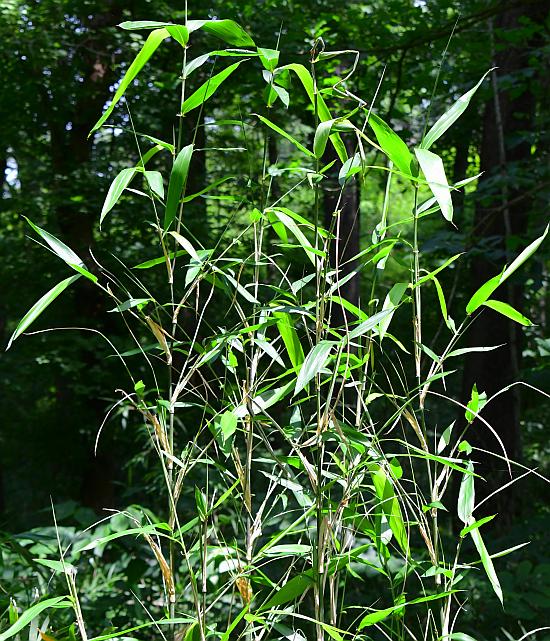Arundinaria gigantea (Walter) Muhl.
Giant Cane

Native
CC = 7
CW = -3
MOC = 29
© SRTurner
Arundinaria gigantea (Walter) Muhl.Giant Cane | |
 |
Native CC = 7 CW = -3 MOC = 29 |
© SRTurner |
|
Family - Poaceae/Bambuseae Habit - Perennial grass with C3 photosynthesis, with long-creeping, branched rhizomes, sometimes forming dense, monocultural stands called "canebreaks." Stems - Aerial stems erect, 0.4-5.0 m tall or more, woody, perennial, persisting aboveground over winter, usually well branched at maturity with side branches smaller than the main stems; new growth in the spring developing at the nodes of existing stems (in addition to new aerial stems from rhizomes).
Leaves - Leaves 10-20 per stem. Leaf sheaths papery at maturity, usually persistent, glabrous or hairy on the surface and hairy along the margins, the ligule composed of several deciduous bristles. Leaf blades 10-30 cm long, 5-60 mm wide, narrowly elliptic to lanceolate or linear (lower leaves), tapered abruptly to a short, petiole-like base, jointed to the sheath, flat, usually hairy on the undersurface, rarely also on the upper surface.
Inflorescences - Loose racemes on short, leafless stems originating from the rhizomes and highly branched panicles originating from the nodes of older, vegetative stems, erect to arched. Spikelets - Spikelets 15-50 mm long, laterally compressed, with 4-12 perfect florets and sometimes 1 or 2 sterile florets at the tip, disarticulating above the glumes. Lower glume 3-6 mm long, rarely absent, elliptic-ovate, pointed at the tip. Upper glume 8-12 mm long, narrowly elliptic-ovate, pointed at the tip. Lemmas 10-25 mm long, lanceolate to narrowly elliptic-ovate, tapered at the tip to a sharp point or short awn, more or less rounded on the back, 11-17-nerved, hairy. Paleas as long as or slightly shorter than the lemma, elliptic-lanceolate, bluntly pointed at the tip, strongly 2-nerved. Stamens 3. Fruits - Fruits 7-8 mm long, elliptic in outline, brown. Flowering - April - May. Habitat - Bottomland forests, streambanks, lake margins, dolomite bluff bases. Origin - Native to the U.S. Lookalikes - Other bamboos (tribe Bambuseae). These are generally not found growing wild in Missouri, but may be encountered as remnants of former homesteads or cultivation events, or possibly as escapes. Other info. - This native bamboo was once more common than today, with large areas once covered by canebreaks. Numerous factors, including altered river hydrology, silting of river beds, overgrazing by livestock, closing in of forest canopy due to fire suppression, and general habitat loss have led to serious declines in its prevalence. Most collections in Missouri have been from southern counties, although scattered populations have been found nearly as far north as the Missouri River. Missouri populations lie on the northwestern edge of the plant's natural range, which encompasses much of the lower Midwest and Gulf Coast states. Photographs taken at Shaw Nature Reserve, Franklin County, MO, 7-21-2020 (SRTurner). |